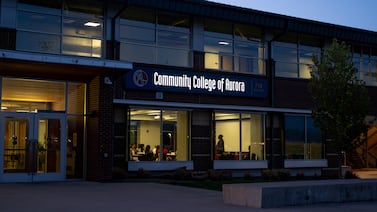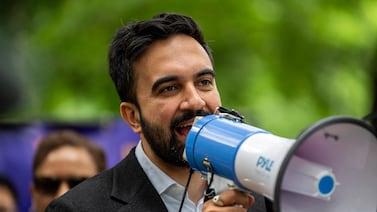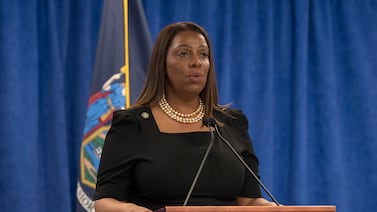To give schools room to experiment, the State Board of Education passed new rules this summer that give Colorado districts full funding this year and next for students enrolled in any type of online program. In exchange, districts must share data showing that those students are actually learning.
Members of the State Board acknowledge they’re taking a risk with students’ education and that it will take time to know what is and isn’t working, but they believe it’s worth it.
“I guess I’m willing to take the risk as opposed to snuffing out the innovation,” State Board member Steve Durham said.
Like most states, Colorado has seen an increase in the number of students learning online since the pandemic began. But the emergency programs created during COVID varied widely and didn’t follow all of the state’s pre-pandemic rules for online programs. Some students worked on paper packets from their schools, while others learned on alternate days. In some districts, students worked online for part of the day and in-person for another part of the day. The amount of interaction students had with teachers varied significantly.
Some teachers, parents, and students complained that efforts to re-create the classroom online were leading to Zoom fatigue and hurting student learning. Some students, including older ones who might be caring for siblings or working a job, valued the flexibility of asynchronous instruction.
As districts look to integrate online learning and technology into their post-pandemic school days, the state wants to know which programs are working before setting the rules for future learning models.
State rules mandate a certain amount of teacher-student contact time so that a student could be counted as enrolled. Student schedules are audited to make sure they meet the minimum amount of contact time to be considered full time or part time students, and then districts receive funding according to how many students they have.
But in the remote settings set up during the pandemic, there are more questions than answers about how to count that contact time.
Before the pandemic, online students in most programs garnered the same amount of money as in person students. But students who were engaged in off-site independent study could not count that independent time towards the hours required for instructional time when it came to funding.
And in some cases, the remote learning offered during the pandemic looked more like independent study.
“Old assumptions about teacher pupil instruction and contact and funding do not apply as neatly or as cleanly as they might have even in the recent past,’’ said Bill Kottenstette, the state’s director of schools of choice.
Board members were clear that while those issues need to be resolved, they shouldn’t stifle innovative programs that work.
“We’re likely, post-pandemic, going to be seeing students and parents with expectations regarding their flexible options that are different than what they had prior to the pandemic,” said State Board member Rebecca McClellan. “My hope is that we can make adjustments that allow students and families to be the drivers of this, because if there are students that are doing better with blended or online or asynchronous learning, I don’t want our auditing process to get in the way of delivering what works best for students.”
State writes new rules
State officials have laid out requirements for various categories of online programs.
For example, districts will be able to set up 100% remote learning models for one more school year to accommodate families with health concerns, similar to last school year, but now students in these programs need to spend at least 20% of each class, each week, learning in real time. If districts want to continue those programs into the future, they would need to get formal state approval.
There are different rules for students taking online supplemental courses, such as a more advanced math class that their school doesn’t offer. No more than 40% of their schedule can be made up of such courses if they’re learning from home. However, for the next two school years, state education officials will grant waivers to these program rules for any district that requests it, so long as districts are willing to share additional student performance data. For example, they want to make sure students taking a larger course load online stay engaged and learn as well as their peers.
During the next year or two, the state will track student attendance and performance data by the model in which they are enrolled. If they seem to serve students well, the state will rewrite rules as needed to make sure the programs are allowed and that districts receive funding for students in those programs. The state could stop districts from using models that don’t meet students’ needs.
In the meantime, waivers ensure funding won’t be cut off if districts do something that doesn’t quite fit the rules.
Reassuring worried districts
Earlier this year, as state officials drafted the guidance, several district and school leaders raised concerns about how the proposed rules would affect their programs and sought clarity about whether they had to change things right away.
The State Board prompted education officials to assure districts that programs would get full funding for two years, rather than one, but also made sharing performance data with the state a requirement, not just a request.
Board members asked state officials to be thoughtful about what data they actually needed to collect. Board members also said data wouldn’t be used to penalize districts, just to inform future decision-making.
Christie Imholt, the director of policy advisement for Aurora Public Schools, raised concerns earlier this year that the state wanted far too much detail on student attendance and engagement. For example, if a student was asked to quarantine and participated in remote learning for a short time, the school would have had to report that.
That was a challenge, she said, because the district’s attendance wasn’t designed to track that. Several districts said they would have the same problem.
The state resolved concerns by not requesting that level of detail. Education officials want to know what learning model students are enrolled in and whether they are in attendance, but not whether they had to attend in a different way on a particular day. They also want to see performance data so they can compare whether students learning in a particular online program were more or less engaged, or showed more or less academic improvement than their peers in traditional in-person classes.
Aurora is offering several learning models next year. Online options for elementary and middle school students will include a mix of live instruction and independent work. High school students will mostly do independent, asynchronous work, though the district will require students to participate in tutoring if they are not completing their work.
As of last week, 364 K-8 Aurora students have signed up to stay in fully remote learning, which next year will have dedicated online teachers. At the high school level, 360 students will learn fully remotely through APS Avenues, which existed before the pandemic.
An additional 319 K-8 Aurora students signed up for a flex model that will allow students to stay connected to their neighborhood schools. They’ll tune in virtually, while teachers work with both the in-person and online students. The flex students will have several chances to switch to in-person instruction if they’re comfortable doing so.
In Hayden, a small district in the mountains east of Steamboat Springs, Superintendent Christy Sinner said her district isn’t planning on having a fully online option this coming school year, but other rural districts are.
She’s concerned that for districts outside of Colorado’s Front Range, internet connectivity could make it hard to offer synchronous live, instruction, and that the 20% rule for how much time should be synchronous, was arbitrary. It’s an example that speaks to a larger issue.
“Truly bottom-line is we need to look at alternatives to seat time, something that’s more competency-based,” Sinner said.
Michael Barbour, associate professor of instructional design at Touro University California, has spent decades studying online learning programs and says the 20% rule doesn’t make much sense. Some students may need more time interacting live with teachers, and others will need less.
Barbour said that he’s found that online programs that are designed to target a specific group of students are more successful than programs that “try to be everything for everyone,” and he worries district models will more likely fall into the latter category.
But as states look for ways to hold online programs more accountable, they should be held to the same student outcomes as brick-and-mortar schools, even if those measures aren’t great either, he said.
Traditionally, corporate providers, sometimes for-profit ones, have been more vocal in driving policies about how online programs are held accountable, he said, but that could change.
“The fact that the school districts are at the table now in a greater capacity, I think, is going to help,” he said.






